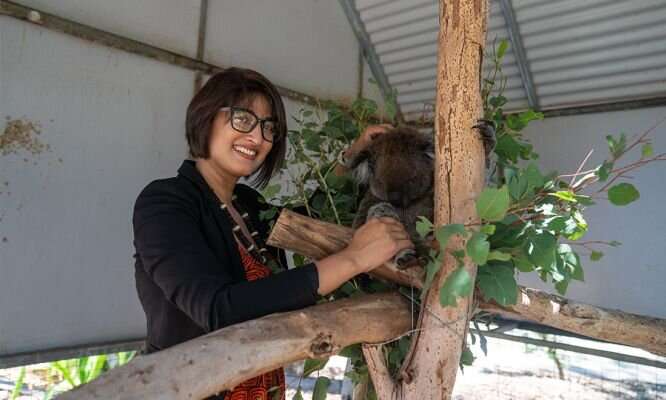Climbing the koala's family tree

Koalas are one of Australia's most beloved marsupials. How can DNA help bring them back from the brink of extinction?
The koala is the latest species to have its DNA digitized and uploaded to the cloud. Its genome joins the quokka as the newest member of the open source online DNA Zoo database.
"They are one of the things which make Australia Australia. They're very, very important from a tourism economy point of view—but they're actually listed as vulnerable to extinction on the IUCN Red List," says Parwinder Kaur, Associate Professor at the Faculty of Science at UWA and Director of DNA Zoo Australia.
A sequenced genome isn't a magic bullet, and it's not going to let us bring the species back from extinction if we lose it. But it's a valuable tool in the conservation toolkit.
Left without a log to stand on
The koala has evolved some pretty unique traits to survive in its environment.
"They happen to be the last representative marsupial from the family called Phascolarctidae," says Parwinder. "There are 20 fossil mammals which are gone, and this is the last one from that family."
The koala is so unique, says Parwinder, that its closest living relative is the wombat.
"The first thing I want to do is align it to the wombat genome and see at the genetic level what has actually happened to separate the two species," she says.
That unique evolutionary pathway, while fascinating, has also made it a challenge to care for.
"Koalas evolved anatomically, , a shifting of the palate towards the front of the skull with larger molars and premolars, to accommodate climate change when the Australian continent began drying out," Parwinder says.
"That led to the decline of rainforests and the spread of open Eucalyptus woodlands."
If that one food source is threatened, either by deforestation or by bushfire, the koala has nowhere else to go. Even where pockets of suitable trees are left, they may not be able to support a large enough population of koalas to maintain genetic diversity.
"First and foremost, we really need to do a genetic diversity analysis of the populations which we've got," Parwinder says. "The populations may look very different but you might see that they are actually, at a genetic level, pretty much inbred."
Disease unease
Inbreeding is a bad enough problem on its own, but it also makes the other challenges the koala's facing much trickier to address. A species' genetic diversity is its toolkit for adapting to new situations. When that toolkit gets smaller, so do the koala's chances of survival.
You might have heard, for instance, that koalas are struggling with a bit of a chlamydia problem.
"In some populations, 100% of koalas have the disease," says Parwinder.
There might be koalas out there with immune genes that help the koala adapt to chlamydia the same way it once adapted to eating eucalyptus. But without a map of the koala's genes, finding that adaptation—and making sure those koalas get included in breeding programs—will be a struggle.
"It's a holistic, grounded scientific way of doing it rather than just, you know, shooting in the dark," she says.
Koala-ty data
This isn't the first time the koala's genome has been sequenced, Parwinder says. Earlier releases have come from The Koala Genome Project, led by Rebecca Johnson from the Australian Museum. What makes the DNA Zoo genome unique is how it's structured—and how it was made.
"Those genomes have got about 1900 pieces instead of bringing those pieces together into 8 chromosomes, which is what we've done."
That makes the genome easier to work with—think of a thousand-piece puzzle compared with an 8-piece one.
"We've already seen that with the genomes which we are releasing. The conservation bodies write to us about how it has made the computational workflow for population analysis less complex and more time and cost efficient."
As for how it's made? Where past genome projects have meant decades of work and planning, this one happened in a few weeks thanks to a chance meeting.
"I just happened to get a sample from the zoo I was visiting in November," she says. "I happened to meet Red, the ranger who's the owner of that zoo as well, and asked him if he'd got any samples to donate in his freezer collections."
"So I helped him clean his freezer … and the rest, literally, it was done in less than a month."
Provided by Particle
This article first appeared on Particle, a science news website based at Scitech, Perth, Australia. Read the original article.



















